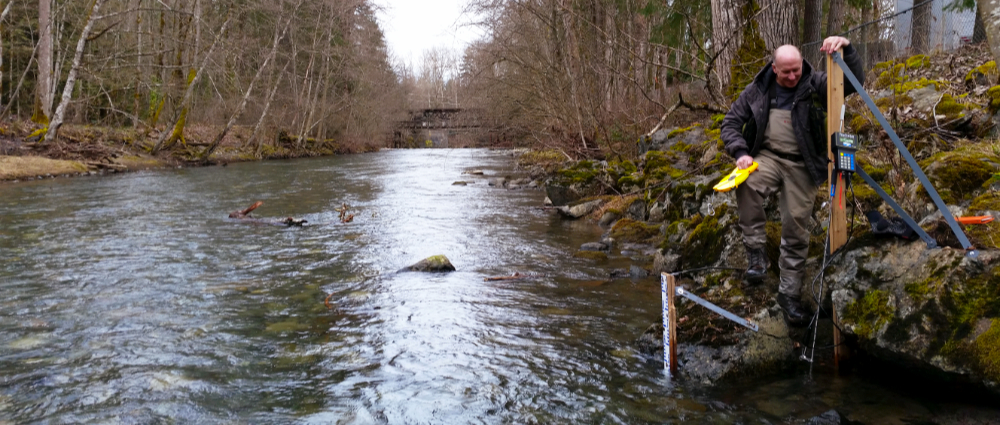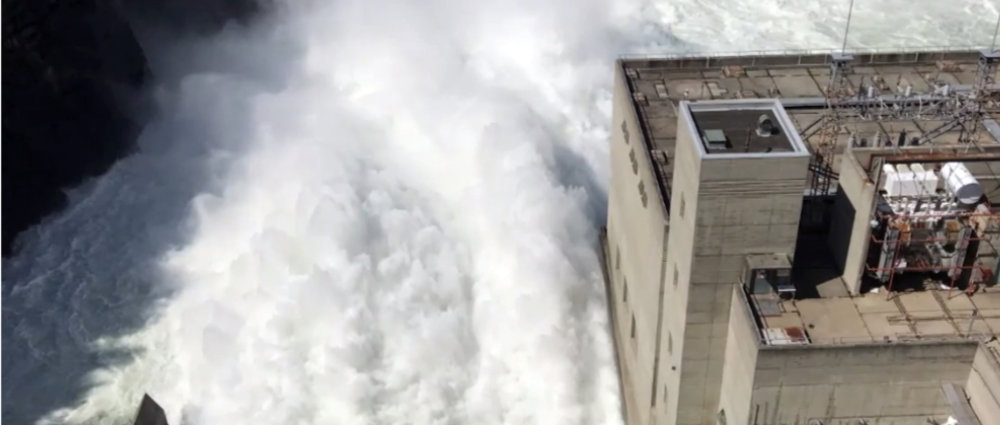Hydrometric tools and projects
Highlighted projects
B.C. Streamflow inventory

Access key streamflow statistics and basin parameters for each hydrometric station from across the Province.
B.C Extreme Flood Project

The project aims to provide critical information for calculating the magnitude of an extreme flood events in B.C.
Learn more about the British Columbia Extreme Flood Project.
Tools, standards, guides and forms
|
Resource name |
|---|
|
Manual of British Columbia Hydrometric Standards, RISC Standards |
|
Hydrometric Field Forms
|
|
Key Hydrometric Planning Questions for Small Stream Monitoring.
|
|
The Role of the Hydrographer in Rating Curve Development
|
|
TidyHYDAT
|
|
HYDAT
|
|
EC Data Explorer
|
|
FASSTR
|
|
FASSTX |
|
Stream Velocity Rod Users Guide |
|
Water Survey of Canada Manuals |
|
WMA Hydroacoustics
|
|
WMO HydroHub, World Meteorological Organization
|
Reports related to hydrometric measurements
| Report name |
|---|
| Arcement, G.J. and V.R. Schneider (1989), Guide for Selecting Manning's Roughness Coefficients for Natural Channels and Flood Plains (PDF). United States Geological Survey, Water Supply Paper 2339. |
| Bos, M.G. (editor) (1989), Discharge Measurement Structures. International Institute for Land Reclamation and Improvement, Delft Hydraulics Laboratory, Wageningen, The Netherlands. |
| British Columbia Ministry of Environment (2006), Continuous Water-Quality Sampling Programs: Operating Procedures (PDF). Prepared by Watershed and Aquifer Science. B.C. Ministry of Environment for the Resources Information Standards Committee. Victoria, B.C. |
| British Columbia Ministry of Environment (2016), Water and Air Baseline Monitoring Guidance Documents for Mine Proponents and Operators, Version 2 (PDF), June 2016. |
| Church, M. (1975), Electrochemical and Fluorometric Tracer Techniques for Streamflow Measurements. British Geomorphological Research Group. Technical Bulletin 12. |
| Church, M. and R. Kellerhals (1970), Stream Gauging Techniques for Remote Areas Using Portable Equipment. Department of Energy, Mines and Resources Inland Waters Branch, Ottawa, Ont. Technical Bulletin 25. |
| Dalrymple, T., and M.A. Benson (1968), Measurement of Peak Discharge by the Slope-Area Method: U.S. Geological Survey Techniques of Water-Resources Investigations, Book 3, Chap. A2. |
| Environment and Climate Change Canada (2016), Hydrometric Manual-Data Computation, Stage-Discharge Model Development and Maintenance. Water Survey of Canada, Environment and Climate Change Canada, Ottawa, Ont. qSOP-NA049-01-2016. |
| Environment and Climate Change Canada (2017), Hydrometric Field Manual – Levelling. Water Survey of Canada, Weather and Environmental Monitoring Directorate, Environment and Climate Change Canada, Ottawa, Ont. qSOP-NA005-03-2017. |
| Environment and Climate Change Canada (2018), Measurement of Stage-SOP (Draft). Water Survey of Canada, Environment and Climate Change Canada, Ottawa, Ont. |
| Environment Canada (1980), Manual of Hydrometric Data Computation and Publication Procedures, Fifth Edition. Inland Waters Directorate, Water Resources Branch, Ottawa, Ont. |
| Environment Canada (1983), Hydrometric Field Manual-Measurement of Stage. Inland Waters Directorate, Water Resources Branch, Ottawa, Ont. |
| Environment Canada (2012), Hydrometric Manual, Data Computations (Beta Version) (PDF). Water Survey of Canada, Environment Canada, Ottawa, Ont. qSOP-NA037 (Beta Version), 2012-12-17. |
| Environment Canada (2015), Measuring Discharge with FlowTracker, Acoustic Doppler Velocimeters (PDF). Water Survey of Canada, Environment Canada, Ottawa, Ont. June 2015, Revision 4, qSOP-NA022-04-2015. |
| Grant, D.M. (2016), ISCO Open Channel Flow Measurement Handbook. 8th edition. ISCO Environmental Division, Lincoln, Nebraska. |
| Hudson, R. and J. Fraser (2002), Alternative Methods of Flow Rating in Small Coastal Streams. B.C. Ministry of Forests, Vancouver Forest Region. Extension Note EN-014 Hydrology. |
| Hudson, R. and J. Fraser (2005), Introduction to Salt Dilution Gauging for Streamflow Measurement Part IV: The Mass Balance (or Dry Injection) Method. Streamline Watershed Management Bulletin 9(1): 6–12. |
| Kite, G. (1993), Computerized Streamflow Measurement Using Slug Injection. Hydrological Processes 7:227–233. |
| Koenig, T.A., J.L. Bruce, J. O’Connor, B.D. McGee, R.R. Holmes, Jr., R. Hollins, B.T. Forbes, M.S. Kohn, M.F. Schellekens, Z.W. Martin, and M.C. Peppler (2016), Identifying and Preserving High-Water Mark Data. U.S. Geological Survey Techniques and Methods, Book 3, Chap. A24. (PDF) |
| Moore, R.D. (2004a), Introduction to Salt Dilution Gauging for Streamflow Measurement: Part 1. Streamline Watershed Management Bulletin 7(4): 20–23. |
| Moore, R.D. (2004b), Construction of A Mariotte Bottle for Constant-Rate Tracer Injection into Small Streams. Streamline Watershed Management Bulletin 8(1): 15–16. |
| Moore, R.D. (2004c), Introduction to Salt Dilution Gauging for Streamflow Measurement Part II: Constant-rate injection (PDF). Streamline Watershed Management Bulletin. 8(1): 11–15. |
| Moore, R.D. (2005), Introduction to Salt Dilution Gauging For Streamflow Measurement Part III: Slug Injection Using Salt In Solution. (PDF) Streamline Watershed Management Bulletin. 8(2): 1–6. |
| Moore, R.D., A. Story, and G. Richards (2008), Electrical Conductivity as an Indicator of Water Chemistry and Hydrological Processes. Streamline Watershed Management Bulletin 11(2): 25–29. |
| NEMS (2013), Open Channel Flow Measurement, Measurement Processing and Archiving of Open Channel Flow Data, (PDF) Version 1.1, June 2013. National Environmental Monitoring Standards, New Zealand. |
| NEMS (2016), Water Level, Measurement Processing and Archiving of Water Level Data, Version 2.0, July 2016 (PDF). National Environmental Monitoring Standards, New Zealand. |
| Rantz, S.E., and others (1982), Measurement and Computation of Streamflow, Volume 1, Measurement of Stage and Discharge (PDF). USGS Water Supply Paper 2175, Washington, D.C. |
| Richardson, M., A. Zimmermann, G. Sentlinger, and R.D. Moore (2017a), Uncertainty in The Relation Between Electrical Conductivity and Salt Concentration, With Application to Dilution Gauging via Dry Salt Injection. Confluence: Journal of Watershed Science and Management. |
| Richardson, M., R.D. Moore, and A. Zimmermann (2017b), Variability of Tracer Breakthrough Curves in Mountain Streams: Implications for Streamflow Measurement By Slug Injection. Canadian Water Resources Journal. 42: 21–37. |
| RISC (2009), Manual of British Columbia Hydrometric Standards, Version 1.0, March 12, 2009. Resources Information Standards Committee, Province of British Columbia, Canada. |
| Sauer, V.B. (2002), Standards for the Analysis and Processing of Surface-Water Data and Information Using Electronic Methods (PDF). U.S. Geological Survey Water-Resources Investigations Report 01-4044. |
| Sauer, V.B., and D.P. Turnipseed (2010), Stage Measurement at Gaging Stations. U.S. Geological Survey Techniques and Methods Book 3, Chap. A7. |
| Terzi, R.A. (1981), Hydrometric Field Manual – Measurement of Streamflow. Environment Canada, Inland Waters Directorate, Water Resources Branch, Ottawa, Ont. |
| Turnipseed, D.P. and V.B. Sauer (2010), Discharge Measurements at Gaging Stations: U.S. Geological Survey Techniques and Methods Book 3, Chap. A8. |
| USBR (2001), Water Measurement Manual (3.3MB, PDF), 3rd Edition. United States Department of the Interior, Bureau of Reclamation Water Resources Research Laboratory, U.S. Government Printing Office, Washington, D.C. |
| Water Survey of Canada (2004), Geo-referencing of Water Survey of Canada Hydrometric Stations (PDF), November 9, 2004. qSOP-NA023-01-2004. |
| WMO (2010a), Manual on Stream Gauging: Volume I – Fieldwork. WMO-No. 1044, World Meteorological Organization. |
| WMO (2010b), Manual on Stream Gauging: Volume II – Computation of Discharge. WMO-No. 1044, World Meteorological Organization. |
If you find a broken web site/document link or if you would like to contribute a resource, please let us know.
